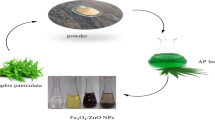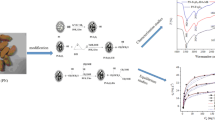Abstract
A novel magnetic adsorbent Fe3O4/Ni/NixB nanocomposite was synthesised and used for the removal of Pb(II) from water. The nanocomposite effectively absorbs Pb(II), and because the adsorbent is magnetic, it is easily separated from the solution. In addition, carob and grape seeds, which are sustainable materials, are also used for the removal of Pb(II) for the first time in the literature. Characterisation of the adsorbents was performed using scanning electron microscopy combined with energy dispersive X-Ray spectroscopy (SEM−EDX). The effect of pH on the adsorption efficiency of Pb(II) was investigated. The optimum adsorbent doses were determined as 2.0 g/L for the Fe3O4/Ni/NixB nanocomposite and 4.0 g/L for the carob and the grape seeds. Three commonly used isotherm models: Langmuir, Freundlich and Dubinin–Radushkevich were applied to the experimental data. The batch adsorption equilibrium data of the three adsorbents fitted well to Langmuir isotherms. The maximum capacities for the adsorption of Pb(II) were determined to be 119.0, 25.3 and 24.4 mg/g for the Fe3O4/Ni/NixB nanocomposite, the carob and the grape seeds, respectively. The dimensionless separation factor (RL) values calculated from the Langmuir isotherm were varied from 0.08 to 1 for three adsorbents. These results demonstrate that the adsorption of Pb(II) on all the adsorbents is favourable. The pseudo-first order, the pseudo-second order and the Weber−Morris intraparticle diffusion kinetic models were used for the identification of the adsorption kinetics of Pb(II) and the correlations of adsorbed Pb(II) with time. The kinetic data is well described with the pseudo-second order kinetic model for all the adsorbents, which indicates that chemisorption plays a dominant role. The adsorption study using a column was successfully applied to real tap water and waste water samples. Also a spiked study (1, 10, 100 mg/L Pb(II)) was also conducted on water samples. As a result, Fe3O4/Ni/NixB nanocomposite, the carob and the grape seeds are efficient adsorbents for the removal of Pb(II) from the water samples.




Similar content being viewed by others
REFERENCES
Kabata-Pendias, A. and Mukherjee, A.B., Trace Elements from Soil to Human, Berlin: Springer, 2007.
Wuana, R.A. and Okieimen, F.E., Heavy metals in contaminated soils: A review of sources, chemistry, risks and best available strategies for remediation, Int. Sch. Res. Not., 2011, vol. 2011, art. ID 402647.
Tchounwou, P.B., Yedjou, C.G., Patlolla, A.K., and Sutton, D.J., Heavy metals toxicity and the environment, Exp. Suppl., 2012, vol. 101, pp. 133–164.
Lead poisoning and health, World Health Organization. https://www.who.int/en/news-room/fact-sheets/detail/lead-poisoning-and-health.
Learn about Lead, United States Environmental Protection Agency. https://www.epa.gov/lead/learn-about-lead.
National primary drinking water regulations for lead and copper: Short-term regulatory revisions and clarifications: Final rule, Federal no. FRL-8476-5, United States Environmental Protection Agency, 2007, p. 40. https://www.gpo.gov/fdsys/pkg/FR-2007-10-10/pdf/E7-19432.pdf.
Guidelines for drinking-water quality, World Health Organization. http://www.who.int/water_sanitation_health/publications/2011/dwq_guidelines/en/.
Zhang, W., Wang, F., Wang, P., Lin, L., Zhao, Y., Zou, P., et al., Facile synthesis of hydroxyapatite/yeast biomass composites and their adsorption behaviors for lead (II), J. Colloid Interface. Sci., 2016, vol. 477, pp. 181–190.
Khokhotva, A.P., Adsorption of heavy metals by a sorbent based on pine bark, J. Water Chem. Technol., 2010, vol. 32, pp. 336–340.
Chakravarty, P., Sen Sarma, N., and Sarma, H.P., Removal of lead(II) from aqueous solution using heartwood of Areca catechu powder, Desalination, 2010, vol. 256, nos. 1–3, pp. 16–21.
Luo, X., Lei, X., Xie, X., Yu, B., Cai, N., and Yu, F., Adsorptive removal of Lead from water by the effective and reusable magnetic cellulose nanocomposite beads entrapping activated bentonite, Carbohydr. Polym., 2016, vol. 151, pp. 640–648.
Liu, Z. and Zhang, F.S., Removal of lead from water using biochars prepared from hydrothermal liquefaction of biomass, J. Hazard. Mater., 2009, vol. 167, nos. 1–3, pp. 933–939.
Ofomaja, A.E., Unuabonah, E.I., and Oladoja, N.A., Competitive modeling for the biosorptive removal of copper and lead ions from aqueous solution by Mansonia wood sawdust, Bioresour. Technol., 2010, vol. 101, no. 11, pp. 3844–3852.
Pehlivan, E., Altun, T., Cetin, S., and Iqbal Bhanger, M., Lead sorption by waste biomass of hazelnut and almond shell, J. Hazard. Mater., 2009, vol. 167, nos. 1–3, pp. 1203–1208.
Malakootian, M., Khodashenas Limoni, Z., and Malakootian, M., The efficiency of lead biosorption from Industrial wastewater by micro-alga Spirulina platensis,Int. J. Environ. Res., 2016, vol. 10, no. 3, pp. 357–366.
Wang, C., Fan, X., Wang, P., Hou, J., Ao, Y., and Miao, L., Adsorption behavior of lead on aquatic sediments contaminated with cerium dioxide nanoparticles, Environ. Pollut., 2016, vol. 219, pp. 416–424.
Henden, E., İşlek, Y., Kavas, M., Aksuner, N., Yayayürük, O., Çiftçi, T.D., and İlktaç, R., A study of mechanism of nickel interferences in hydride generation atomic absorption spectrometric determination of arsenic and antimony, Spectrochim. Acta, Part A, 2011, vol. 66, no. 11, pp. 793–798.
İşlek Coşkun, Y., Çiftçi, T.D., and Henden, E., A novel nanoadsorbent Ni/NixB for preconcentration of arsenic(III) and arsenic(V) before hydride generation-atomic absorption spectrometric determination, Desalin. Water Treat., 2016, vol. 57, no. 43, pp. 20411–20421.
Langmuir, I., The adsorption of gases on plane surfaces of glass, mica and platinum, J. Am. Chem. Soc., 1918, vol. 40, no. 9, pp. 1361–1403.
Freundlich, H., About the adsorption in solutions, Z. Phys. Chem., 1906, vol. 57, pp. 385–470.
Mahramanlioglu, M., Kizilcikli, I., and Bicer, I.O., Adsorption of fluoride from aqueous solution by acid treated spent bleaching earth, J. Fluorine Chem., 2002, vol. 115, no. 1, pp. 41–47.
Lagergren, S., About the theory of so-called adsorption of soluble substances, K. Sven. Vetenskapsakad. Handl., 1898, vol. 24, no. 4, pp. 1–39.
Ho, Y.S. and McKay, G., Pseudo-second order model for sorption processes, Process. Biochem., 1999, vol. 34, no. 5, pp. 451–465.
Weber, W.J., Jr. and Morris, J.C., Kinetics of adsorption on carbon from solution, J. Sanit. Eng. Div., Am. Soc. Civ. Eng., 1963, vol. 89, no. 2, pp. 31–59.
Nadaroglu, H., Kalkan, E., and Demir, N., Removal of copper from aqueous solution using red mud, Desalination, 2010, vol. 251, nos. 1–3, pp. 90–95.
Ahmad Zaini, M.A., Amano, Y., and Machida, M., Enhanced lead(II) binding properties of heat-treated cattle-manure-compost-activated carbons, Desalin. Water Treat., 2014, vol. 52, nos. 34–36, pp. 6420–6429.
Aliyeva, S., Maharramov, A., Azizov, A., Alosmanov, R., Buniyatzadeh, I., and Eyvazova, G., Phosphorus-containing polybutadiene rubber-bentonite hybrid composite for the removal of rhodamine 6g from water, Anal. Lett., 2016, vol. 49, no. 14, pp. 2347–2364.
Poots, V.J.P., McKay, G., and Healy, J.J., The removal of acid dye from effluent using natural adsorbents. I. Peat, Water Res., 1976, vol. 10, no. 12, pp. 1061–1066.
Goncharuk, V.V., Puzyrnaya, L.N., Pshinko, G.N., Bogolepov, A.A., and Demchenko, V.Ya., Comparative research of removing ions of heavy metals from aqueous solutions with montmorillonite modified by polyethylenimine, J. Water Chem. Technol., 2011, vol. 33, no. 3, pp. 147–152.
ACKNOWLEDGMENTS
I would like to thank high school students Tibet Çiğdem and Atilla Selim Dinç and their teacher Serpil Yapıcı for their kind help during laboratory studies.
Author information
Authors and Affiliations
Corresponding author
About this article
Cite this article
Tülin Deniz Çiftçi, Yasemin İşlek Coşkun Removal of Pb(II) from Water Using (Fe3O4/Ni/NixB) Magnetic Nanocomposites, Carob (Ceratonia siliqua) or Grape Seeds (Vitis vinifera). J. Water Chem. Technol. 42, 185–195 (2020). https://doi.org/10.3103/S1063455X2003011X
Received:
Revised:
Accepted:
Published:
Issue Date:
DOI: https://doi.org/10.3103/S1063455X2003011X




